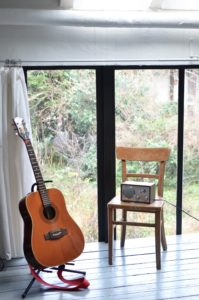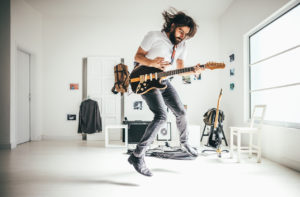JP BLOG
Share this
When we think about music, we think sound. But what plays the sound? The instrument. And what plays the instrument? The musician. But what plays the musician? The space.
To transform a space into a place is to combine the physical with meaning, and then experience and interact with that meaning. This might sound a bit too “out” but remember, music is just vibrations in the air translated into electrical signals in the brain.
The mindful musician can create a place and harness its effects and use them the same way a guitarist uses a pedal board, or an organ player uses their stops. For performing musicians this is a must-have ability, and for practicing or private musicians it is just as vital.
Your practice space can either help or harm you on your path to building a relationship with your instrument and your music. To help you on your way, I want to share a few thoughts I’ve had over the years while trying to transform spaces into places.
On Bedrooms

Virtually everyone starts out practicing in their bedroom. It makes sense. Your bedroom is your most personal, inner sanctum. It’s where you keep your things and it’s where you keep yourself.
Likewise you are surrounded by distractions, i.e. the things in your life that aren’t music. Your bedroom is already a place, you’re just adding music to it. Now this isn’t the end of the world, provided you can discipline yourself and keep the distractions at bay while you practice.
Get rid of your phone. Turn it off. Put it in another room. Bury it in your backyard. I don’t care, just get rid of it. If you use your laptop to practice (as I do), don’t fall down a Youtube rabbit hole watching music theory videos and band documentaries. Those videos are great for getting inspired but if they’re cutting into your practice time or serving as sources of procrastination, cut them out. You’d be better served spending quality time with a metronome and practicing the songs and concepts you’re trying to master.
TL;DR discipline is key if you’re practicing in your bedroom.
On Basements/Garages
These two spaces share a lot in common. They’re both separated from the normal functions of a house. They’re both quintessential “hobby-zones.” They’re both where people go to work on their passions.
Just about every band in the last 50 years got their start in a basement or a garage. There are whole genres and albums built around that aesthetic (@ The Basement Tapes). I distinctly remember being 16 years old, just starting out on bass, playing awful covers of Nirvana and Radiohead in my friend’s dark, unfinished basement.
It was glorious.
But what basements and garages lack in distraction they make up for in their atmosphere. Unless you’re really into grunge or doom metal (and hey, all power to you) a cave-like, serial killer atmosphere probably isn’t the greatest place for your creativity to thrive.
But this really has to do with your mindset as a practicing musician. Are you going to the basement/garage to work, or to play? If you’re treating these spaces as a place of “responsibility escape,” you’ll have a great time; but you’ll also be taking away responsibility for your music, so be mindful.
On The Band Room
For you lucky souls that have had the opportunity to dedicate four walls or more to music, I salute you. There is no space more hallowed in the world of music than the band room
It can be as large as a concert hall and it can be a glorified closet. It can be a cramped attic loft and it can be an unused classroom. It can be an outdoor amphitheater and it can be a street corner. As long as it belongs to the music while you’re there, it’s the band room
Unless you’re a weird hermit-monk (you know who you are and I’m looking at you), you’re going to make most of your progress as a musician with other musicians. So having a proper place for your band to practice and be comfortable practicing in, is crucial to becoming a better player and a better band.
 Use common sense, or don’t, whatever works for you. If you’re playing metal, put some Iron Maiden posters up. If you’re playing psychedelic rock, put up a tie-dye tapestry and some cool lights (cool lights are a necessity, more important than amplifiers and talent combined). If you’re playing jazz, put up a Jackson Pollock painting and pretend like you know what you’re doing.
Use common sense, or don’t, whatever works for you. If you’re playing metal, put some Iron Maiden posters up. If you’re playing psychedelic rock, put up a tie-dye tapestry and some cool lights (cool lights are a necessity, more important than amplifiers and talent combined). If you’re playing jazz, put up a Jackson Pollock painting and pretend like you know what you’re doing.
On Your Mind
The saddest fact of life is that no place is permanent. If you’re a touring musician you’ll be practicing in planes, trains, and automobiles. If you’re a student you’ll be practicing in deserted dorm hallways and study lounges. If you’re a human being you’ll be practicing in spaces you might have never expected to find yourself in.
The goal of turning a practice space into a practice place is to encourage an inner state of comfort and discipline, of freedom and direction, that you can carry around with you. That place in your head can be an imagined location, a mantra, or the memory of a feeling that you keep bottled up inside your mind like water from a sacred river. The point is if you have that place within you at all times, you’ll always be able to practice diligently and deliberately. When James Hetfield worked in a factory in L.A., he practiced out in his car on his lunch breaks. During shows, John Coltrane would go play his saxophone in the bathroom in between sets. Where were they practicing?
You who drum constantly on your school desk, who play scales on your guitar in bed while you’re falling asleep, who practice slapping and popping motions for bass on every surface imaginable, you are accessing a practice place more real and more integral to your musicianship than any physical location on earth. You’re accessing yourself.
JamPlay is home to more than 500,000 guitarists with guitar lessons from world class instructor artists in every genre and for every interest to power up your guitar skill. Join at JamPlay.com.


